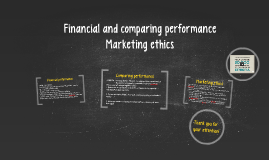Financial Performance
Transcript: Corpo. Social Responsibility (1/3) Business and Customers (2/2) Company Profile (1/1) Chase takes pride in working to develop vibrant and diverse communities capable of sustaining a high quality of life and economic opportunity. Philosophy They distinguish themselves as a national leader in community development by providing loans, investments and community development services. Q & A JP Morgan Chase Go- Green (1/3) Go- Green (3/3) Presented By: Jimy Flores Lin Jeff Kevin Josh William Presented To: Mr. Tao Yu Cheng Taiwan (R.O.C.) December 24th, 2013. Corporate Culture (2/2) JPMorgan Chase & Co., the parent company of J.P. Morgan Securities, is a leading global financial services firm with operations in more than 60 countries. The firm is a leader in asset management, investment banking, private banking, treasury and securities services and commercial banking. Business and Customers (1/2) Linking management rewards to progress in achieving diversity. Identifying top talent and building development plans accordingly. Seeking a diverse slate of candidates for all key job openings. Building a pipeline for diverse talent by working closely with universities and key industry groups. 4.10 Board access to outside resources. 4.11 Director orientation and continuing education 4.12 Code of business conduct and ethics 5. Other matters: 5.1 Transactions with immediate family members. 5.2 Confidential voting. Repricing of stock options. 5.4 Bonus recoupment policy. 5.5 Poison pills. 5.6 Proposed transactions. 5.7 Communications with the Board Go- Green (2/3) Core Values: Performance Partnership Meritocracy Inclusion Directness . Diversity (2/2) Company profile Vision Mission Core values and business philosophy Business and Customers Financial Performance Corporate Culture Leadership Diversity Go- Green Corp. Social Responsability Corporate Governance Innovation and Technology Business Management Conclusions Reference 2. Board Composition: 2.1 Size and composition of the Board 2.2 Definition of independence. 2.3 Former officer-directors. 2.4 Change of job responsibility. 2.5 Director tenure. 2.6 Retirement age. 2.7 Limits on board and audit committee memberships. 2.8 Majority voting for directors. 2.9 Stock ownership requirements. At JPMorgan Chase, they want to be the best financial services company in the world. Because of their great heritage and excellent platform, they believe this is within our reach. Corporate Governance (3/4) 1. Functions of the Board: 1.1 Criteria for composition of the Board, selection of new directors. 1.2 Assessing the Board´s performance 1.3 Formal evaluation of the Chairman and the Chief Executive Officer. 1.4 Succession planning and management development. 1.5 Strategic Reviews. 1.6 Board and management compensation review On this site, organizations of all sizes can learn about the latest developments in the global "Go Green" initiative and how they can implement. Jpmorgan Chase Website.(2013, November). JPMorgan Chase & CO. jpmorganchase.com. Retrived November 9th, 2013 from http://www.jpmorganchase.com/corporate/About-JPMC/aboutus.htm Being the best requires working together – across time zones, languages and borders. That can only take place in an environment where people respect, value and support one another. Actively involving their people – through employee networking groups, annual forums, open discussions with senior leaders, seeking input on multicultural marketing efforts, and partnering on community activities. Offering a comprehensive set of policies, programs and benefits to meet the changing needs of a wide spectrum of individuals. J.P. Morgan have helped more than 10,000 clients worldwide transition their paper-intensive treasury functions into leaner, greener, higher performing electronic operations. (1/2) Content Corporate Culture Business Management They have a code of ethics to promote honest and ethical conduct and compliance with the law, particularly as related to the maintenance of the firm's financial books and records and the preparation of its financial statements. This Code of Ethics applies to the Chief Executive Officer, President, Chief Financial Officer, and Chief Accounting Officer. J.P. Morgan : Investment Bank. Asset Management. Treasury Services. Worldwide Securities Services. Private Banking. The commercial banking businesses include: Corporate Client Banking. Government, Not-for-Profit and Healthcare Banking. Real Estate Banking. International Banking Innovation and Technology Vision Corp. Social Responsability(2/3) Company Profile (2/2) They need to constantly remind thereselves that the most important thing they can do for employees is to build a healthy, vibrant company that treats people with respect and creates opportunity. Everyone counts, and they have to remember that they all support one another. Conclusions Leadership Mission As part of their commitment to advancing eco-friendly treasury practices, they have created the Go Green Resource

















